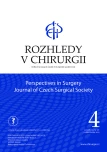Partial jejunal diversion (PJD) with jejunocolic anastomosis − preliminary results of a pilot study
Authors:
P. Holéczy 1,2; M. Bužga 3; M. Bolek 1; M. Pekař 1,4
Authors‘ workplace:
Chirurgické oddělení Nemocnice AGEL Ostrava-Vítkovice, Ostrava
1; Katedra chirurgických oborů, Lékařská fakulta, Ostravská univerzita, Ostrava
2; Centrum nutričního výzkumu a obezity, Lékařská fakulta, Ostravská Univerzita, Ostrava
3; Fyziologický ústav, Lékařská fakulta, Masarykova Univerzita, Brno
4
Published in:
Rozhl. Chir., 2022, roč. 101, č. 4, s. 163-167.
Category:
Original articles
doi:
https://doi.org/10.33699/PIS.2022.101.4.163–167
Overview
Introduction: Bariatric-metabolic surgery is an effective tool in the treatment of severe obesity and related diseases. Its importance has increased even more in the era of the type II diabetes mellitus and COVID 19 pandemics. The aim of our study is to present the initial results of a new operation that minimizes surgical trauma.
Methods: In the prospective study, laparoscopic side-to-side anisoperistaltic jejunocolic anastomosis was constructed in order to derive part of the chyme by the anastomosis. Patients were operated in the period of IV/2018−VII/2019; their mean age was 48.43±10.36 years, mean weight 112.3±16.6 kg and mean BMI 41.9±5.2. Patients were examined one month before surgery and then followed at 3, 6 and 12 months after surgery. We evaluated weight loss and changes in carbohydrate metabolism.
Results: We did not record any perioperative or postoperative surgical complications. There was a statistically significant weight loss during the study period. There was a significant decrease in absolute weight in kilograms (p<0.001) and in BMI (p<0.001). The reduction in overweight expressed by the EWL (excess weight loss) index was 82.9% after 12 months. As regards the carbohydrate metabolism, we observed a statistically significant reduction in fasting blood glucose after three months (p=0.04) and after six months (p=0.03). Blood glucose values were reduced after 12 months; however, no statistical significance was demonstrated (p=0.09). Although a decrease in glycated hemoglobin A1c (HbA1c) was reported, no statistical significance was demonstrated.
Conclusion: Our proposed operation represents a new option in the treatment of severe obesity and related diseases. Preliminary results are promising. It will be necessary to monitor a larger number of patients over a longer period.
Keywords:
metabolic surgery – bariatric surgery – type II diabetes mellitus – partial jejunal diversion – jejunocolic anastomosis
Sources
1. Hussain A, Mahawar K, El-Hasani S. The impact of COVID-19 pandemic on obesity and bariatric surgery. Obes Surg. 2020 Aug 9;30(8):3222–3223. doi:10.1007/ s11695-020-04637-7.
2. Kwok S, Adam S, Ho JH, Iqbal Z, et al. Obesity: A critical risk factor in the COVID‐19 pandemic. Clin Obes. 2020 Dec 28;10(6). doi:10.1111/cob.12403.
3. Deitel M. From the editors’ desk ….. The international obesity task force and “globesity”. Obes Surg. 2002 Oct 1;12(5):613– 614. doi:10.1381/096089202321019558.
4. Ng ACT, Delgado V, Borlaug BA, et al. Diabesity: the combined burden of obesity and diabetes on heart disease and the role of imaging. Nat Rev Cardiol. 2021 Apr 13;18(4):291–304. doi: 10.1038/s41569- 020-00465-5.
5. Di Cesare M, Sorić M, Bovet P, et al. The epidemiological burden of obesity in childhood: a worldwide epidemic requiring urgent action. BMC Med. 2019 Dec 25;17(1):212. doi: https://doi. org/10.1186/s12916-019-1449-8.
6. Fried M, Hainer V, Basdevant A, et al. Interdisciplinary European guidelines on surgery of severe obesity. Obes Facts. 2008;1(1):52–59. doi: 10.1159/000113937.
7. De Luca M, Angrisani L, Himpens J, et al. Indications for surgery for obesity and weight-related diseases: Position statements from the International Federation for the Surgery of Obesity and Metabolic Disorders (IFSO). Obes Surg [Internet]. 2016 Aug 13;26(8):1659–1696. doi: 10.1007/s11695-016-2271-4.
8. Angrisani L, Santonicola A, Iovino P, et al. Bariatric surgery worldwide 2013. Obes Surg. 2015;25(10):1822–1832. doi: 10.1007/s11695-015-1657-z.
9. Melissas J, Peirasmakis D, Lamprou V, et al. Is a simple food-diverting operation the solution for type 2 diabetes treatment? Experimental study in a non-obese rat model. Obes Surg. 2016;26(issue 5):1010–1015. doi:10.1007/s11695-016- 2251-8. doi:10.1007/s11695-016-2251-8
10. Melissas J, Peppe A, Askoxilakis J, et al. Sleeve gastrectomy plus side-to-side jejunoileal anastomosis for the treatment of morbid obesity and metabolic diseases: A promising operation. Obes Surg. 2012;22(7):1104–1109. doi: 10.1007/ s11695-012-0637-9..
11. Melissas J, Eren Taskin H, Peirasmakis D, et al. A simple food-diverting operation for type 2 diabetes treatment. Preliminary results in humans with BMI 28–32 kg/m2. Obes Surg. 2017;27(1):22–29. doi: :10.1007/s11695-016-2251-8.
12. Fried M, Dolezalova K, Chambers AP, et al. A novel approach to glycemic control in type 2 diabetes mellitus, partial jejunal diversion: Pre-clinical to clinical pathway. BMJ Open Diabetes Res Care. 2017;5(1):1– 9. doi: 10.1136/bmjdrc-2017-000431.
13. Machytka E, Bužga M, Zonca P, et al. Partial jejunal diversion using an incisionless magnetic anastomosis system: 1-year interim results in patients with obesity and diabetes. Gastrointest Endosc. 2017 Nov;86(5):904–912. doi: 10.1016/j. gie.2017.07.009.
14. Holéczy P, Bužga M, Macháčková J, et al. Parciální jejunální diverze – technické aspekty a počáteční zkušenosti. Gastroenterol a Hepatol. 2018;72(6):490–494. doi:10.14735/amgh2018490.
15. Fried M, Ribaric G, Buchwald JN, et al. Metabolic surgery for the treatment of type 2 diabetes in patients with BMI <35 kg/m2: An integrative review of early studies. Obes Surg. 2010;20(6):776–790. doi: 10.1007/s11695-010-0113-3.
16. Peterli R, Steinert RE, Woelnerhanssen B, et al. Metabolic and hormonal changes after laparoscopic Roux-en-Y gastric bypass and sleeve gastrectomy: A randomized, prospective trial. Obes Surg. 2012;22(5):740–748. doi: 10.1007/ s11695-012-0622-3.
17. Haluzík M, Kratochvílová H, Haluzíková D, et al. Gut as an emerging organ for the treatment of diabetes: Focus on mechanism of action of bariatric and endoscopic interventions. J Endocrinol. 2018;237(1):R1–R17. doi: 10.1530/JOE- 17-0438.
Labels
Surgery Orthopaedics Trauma surgeryArticle was published in
Perspectives in Surgery

2022 Issue 4
Most read in this issue
- Our technique of thoracoscopic first rib resection – case report
- Achalasia – position of surgery in current management
- Potential use of mesenchymal stem cells in the treatment of inflammatory bowel disease – a systematic review of the literature
- 30 let miniinvazivní chirurgie v České republice
